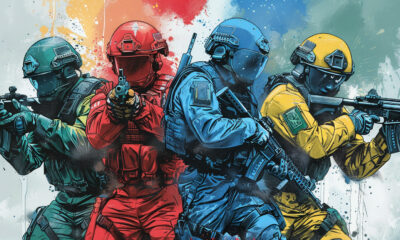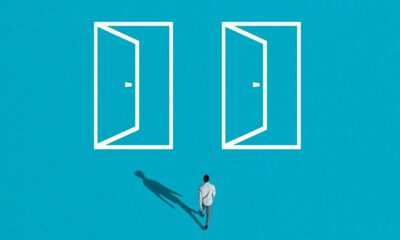TECHNOLOGY
Productivity Hacks for Remote Workers

It’s no surprise that these days, there seem to be more and more opportunities for remote work, and an increasing creation of “distributed” workplaces.
While the allure of working from home (or being able to work from “anywhere”) can be exceedingly appealing, let me be the first to tell you remote work is a lot more difficult than just casually sitting with your laptop on the beach.
When settling into remote work, there are a few different tricks you can use to be your most productive self, instead of feeling stressed, demotivated, and regretting the day you ever went “location independent.”
The Practical Aspects of Remote Work
There are a few different approaches to remote work these days. You may be a full-time employee to one company that allows you to work from home, or that doesn’t even have a specific headquarters, but instead has built an entire distributed team (think companies like Buffer). Or, perhaps you are a freelancer or contractor who may work with a number of different projects or companies where you are not required to be on location.
In any case, you may have opportunities to move around freely, or you’d rather stay put in one place. In the latter case, perhaps you choose to work from home or rent an office, or have a membership at a coworking space.
With many different options, how you do remote work is completely up to you. But there are some basic challenges that remote workers in every type of situation can feel. Staying personally motivated, reducing distractions, and being efficient in work execution are on the top.
For me at least, the key to being more productive while working remotely has been to admit when I’m struggling, and be aware of the conditions that I would like to work in, but just aren’t feasible for my productivity. Remote work solutions can be very individual depending on what motivates you, what kind of hours you like to keep, and what types of environments you thrive in.
Non-Tech Hacks for Remote Workers
Some of the best solutions for remote worker productivity have nothing to do with technology or fancy techniques. When thinking about how to be productive when working remotely, often the best thing to do is to start with the basics.
Stick to a Routine
You’ve probably heard this before, but it’s crucial for remote workers to create a routine, and stick to it. Some of us remote workers may be rebels when it comes to keeping to the ordinary, but routines aren’t boring, they’re necessary for being productive.
Without a routine, you can often waste a ton of time just figuring out what you want or need to do next. If you don’t have a schedule for your morning, like reading your emails by 9:30, checking and making your daily to-do list by 9:45, and getting started on completing your first task by 10:00, you may find yourself rounding 10:30 and all you’ve done so far is had four cups of coffee and checked facebook.
Routines create some semblance of structure, and structure is actually a really necessary component of being productive with remote work.
Create Some Variety
But sometimes too much routine or structure can stifle creativity and the execution of your best work. Monotony isn’t good for anyone’s work satisfaction, so find out how and where you work best. Variety may be sitting at your kitchen table to work for the morning hours, and then switching it up to your home office in the afternoon. Or, perhaps you find a coworking space that gives you a nice change of scenery a couple days a week.
Variety (with structure) can be good for helping you to get out of mental ruts, and can help to inspire you in some ways. Not to mention, if you are only working from home it can be at least slightly more difficult to hold yourself accountable when there is no one else there who can see you doing work, or for you to talk to and discuss ideas with. Even just getting out to a coffee shop to work from may be beneficial for your productivity levels.
Get Ready For Your Day
I’ll admit, I’ve had more than a few “Donald Duck” video meetings: I may be dressed professionally on top, with my hair done and teeth brushed, but out of the line of site of the camera, I may or may not be wearing pants. When working from home it can be so tempting to throw on the same sweatshirt you’ve been wearing for the past four days. But this can be detrimental to your productivity.
Getting up and taking a shower, getting properly dressed and ready as if you are going to the office, will get you in the right mindset for your work day. It can make you feel more awake, in a working mood, and it’s the first thing you can check off your list of accomplishments. When working remotely, you need to count every win.
Leave the House
It’s a common conundrum for remote workers: a whole day passes and you think to yourself, “have I spoken to another human today?” When working from home especially, you can sink into the bad habit of not getting out enough or interacting with others, but this can be problematic for your productivity.
Just getting out of your house, even to grab a coffee down the street, or taking a drive to the store, can be a quick and easy way to refresh your motivation and jump-start your energy. Not to mention that the benefit of remote work can be flexible, but sitting at home all day is not making the most of that benefit, no matter how much you enjoy the nonexistent commute.
Create a Hard Line between Professional Life and Private Life
When you aren’t being watched over by a manager, or there is no one really keeping tabs on the hours you keep, the problem isn’t always that you don’t work enough. The problem may be that you don’t set hard boundaries for what is work and what is personal.
In the beginning of my venture into working remotely, I found myself wanting to be eager, available, and seemingly always on top of things. What that translated to, was answering emails at all hours of the night, never really “logging off,” and finding the lines between my professional life and private life completely blurred.
But the fact is, it made me stressed all the time, and the companies I worked for didn’t really notice a difference in my work ethic. Work issues bled into my nights and weekends and free time until I felt that I was in work mode basically 24/7. And as it turns out, it killed my productivity when I needed it most.
Setting hard boundaries, and establishing the precedent to your company or customers about sticking to specific hours can be crucial for your motivation and also your sanity. Be sure to create that hard-line early on, so that you know when to be in productive time, and when you can (and should) relax.
Fill Your Time
As with procrastination, remote work has a fun way of making even small projects take up all the time you have available. The less busy you are, the less efficient you’ll actually be. When you have a lot to do, and a lot to fill your time with, that is when you’ll actually be your most productive.
Especially if you are just starting out freelancing and are still collecting projects to fill your docket, block your days for work, and then your days for doing errands or job searching, or whatever else you need to do. If you try to fill your 40 hour work week with only 20 hours of work, you’ll be slow, inefficient, and definitely not cost-effective. Try to get as much work assignments as you can, because when you can fill your time with actual work, then you will be more productive.
Tech hacks for remote workers
Remote workers would be nowhere if it wasn’t for the plethora of productivity and collaboration tools that are now available to us. While self-motivation and old school methods for productivity can create a good foundation, the tech will be your friend when working remotely.
Rely on Productivity Tools
Thankfully, productivity tools for that are beneficial for remote work are basically an industry in and of itself. There are many different options you can use for being the most productive.
Project management tools like Asana and Trello can help you stay the course when it comes to just getting things done. With these types of tools, you’ll have a good overview of what you need to complete and when, and at what stage each project is in, or if you need input from others to complete tasks.
Task management tools like Wunderlist and Todoist can be awesome for tackling to-dos, especially for visual people who like to look at a clear overview of what needs to be prioritized or if there are impending deadlines. Time trackers like Toggl and The Pomodoro Tracker can help you be more aware of the time you spend on different projects or just work in general and can help you to be better about being productive in sprints.
Limit Tech Distractions
While you should use tech to help you be more productive, sometimes those tools should work to actually limit the number of distractions you have, and what you have access to. Social media, email, RSS feeds, news notifications, personal messaging apps, and many others can cause major problems for remote workers. Use app blockers like Freedom or Self Control to ensure you can turn off the things that are not essential for getting your work done.
Collaborate as Much as You Can
While remote work lends itself to a lot of independence and autonomy, it can actually really help your productivity to collaborate with others. On one hand, working with a team that relies on you and vice versa can give you some accountability for completing tasks in a timely way. But it can also cure some of the side effects of working “alone” like basic loneliness, or mental blocks.
Collaboration tools make working with distributed teams a non-issue. In many ways, they can encourage us to be more efficient in our communication, and be very transparent in our work. Communication apps like Slack, doc sharing such as Google Drive, Dropbox, and Basecamp, and video conferencing with Zoom, or GoToMeeting, make collaboration easier than ever.
Remote work can be a great experience and can allow you to have freedom, flexibility, and autonomy like you’ve never had in work before. But it can be very easy to fall down a rabbit hole of bad habits, distractions, and lack of motivation. Be honest with yourself about the kinds of environments that are best for your productivity, keep routines and structure, and use the right tools to help you stay on top of your assignments, and you’ll have no problem being successful working remotely.
Source link
TECHNOLOGY
Next-gen chips, Amazon Q, and speedy S3

AWS re:Invent, which has been taking place from November 27 and runs to December 1, has had its usual plethora of announcements: a total of 21 at time of print.
Perhaps not surprisingly, given the huge potential impact of generative AI – ChatGPT officially turns one year old today – a lot of focus has been on the AI side for AWS’ announcements, including a major partnership inked with NVIDIA across infrastructure, software, and services.
Yet there has been plenty more announced at the Las Vegas jamboree besides. Here, CloudTech rounds up the best of the rest:
Next-generation chips
This was the other major AI-focused announcement at re:Invent: the launch of two new chips, AWS Graviton4 and AWS Trainium2, for training and running AI and machine learning (ML) models, among other customer workloads. Graviton4 shapes up against its predecessor with 30% better compute performance, 50% more cores and 75% more memory bandwidth, while Trainium2 delivers up to four times faster training than before and will be able to be deployed in EC2 UltraClusters of up to 100,000 chips.
The EC2 UltraClusters are designed to ‘deliver the highest performance, most energy efficient AI model training infrastructure in the cloud’, as AWS puts it. With it, customers will be able to train large language models in ‘a fraction of the time’, as well as double energy efficiency.
As ever, AWS offers customers who are already utilising these tools. Databricks, Epic and SAP are among the companies cited as using the new AWS-designed chips.
Zero-ETL integrations
AWS announced new Amazon Aurora PostgreSQL, Amazon DynamoDB, and Amazon Relational Database Services (Amazon RDS) for MySQL integrations with Amazon Redshift, AWS’ cloud data warehouse. The zero-ETL integrations – eliminating the need to build ETL (extract, transform, load) data pipelines – make it easier to connect and analyse transactional data across various relational and non-relational databases in Amazon Redshift.
A simple example of how zero-ETL functions can be seen is in a hypothetical company which stores transactional data – time of transaction, items bought, where the transaction occurred – in a relational database, but use another analytics tool to analyse data in a non-relational database. To connect it all up, companies would previously have to construct ETL data pipelines which are a time and money sink.
The latest integrations “build on AWS’s zero-ETL foundation… so customers can quickly and easily connect all of their data, no matter where it lives,” the company said.
Amazon S3 Express One Zone
AWS announced the general availability of Amazon S3 Express One Zone, a new storage class purpose-built for customers’ most frequently-accessed data. Data access speed is up to 10 times faster and request costs up to 50% lower than standard S3. Companies can also opt to collocate their Amazon S3 Express One Zone data in the same availability zone as their compute resources.
Companies and partners who are using Amazon S3 Express One Zone include ChaosSearch, Cloudera, and Pinterest.
Amazon Q
A new product, and an interesting pivot, again with generative AI at its core. Amazon Q was announced as a ‘new type of generative AI-powered assistant’ which can be tailored to a customer’s business. “Customers can get fast, relevant answers to pressing questions, generate content, and take actions – all informed by a customer’s information repositories, code, and enterprise systems,” AWS added. The service also can assist companies building on AWS, as well as companies using AWS applications for business intelligence, contact centres, and supply chain management.
Customers cited as early adopters include Accenture, BMW and Wunderkind.
Want to learn more about cybersecurity and the cloud from industry leaders? Check out Cyber Security & Cloud Expo taking place in Amsterdam, California, and London. Explore other upcoming enterprise technology events and webinars powered by TechForge here.
TECHNOLOGY
HCLTech and Cisco create collaborative hybrid workplaces

Digital comms specialist Cisco and global tech firm HCLTech have teamed up to launch Meeting-Rooms-as-a-Service (MRaaS).
Available on a subscription model, this solution modernises legacy meeting rooms and enables users to join meetings from any meeting solution provider using Webex devices.
The MRaaS solution helps enterprises simplify the design, implementation and maintenance of integrated meeting rooms, enabling seamless collaboration for their globally distributed hybrid workforces.
Rakshit Ghura, senior VP and Global head of digital workplace services, HCLTech, said: “MRaaS combines our consulting and managed services expertise with Cisco’s proficiency in Webex devices to change the way employees conceptualise, organise and interact in a collaborative environment for a modern hybrid work model.
“The common vision of our partnership is to elevate the collaboration experience at work and drive productivity through modern meeting rooms.”
Alexandra Zagury, VP of partner managed and as-a-Service Sales at Cisco, said: “Our partnership with HCLTech helps our clients transform their offices through cost-effective managed services that support the ongoing evolution of workspaces.
“As we reimagine the modern office, we are making it easier to support collaboration and productivity among workers, whether they are in the office or elsewhere.”
Cisco’s Webex collaboration devices harness the power of artificial intelligence to offer intuitive, seamless collaboration experiences, enabling meeting rooms with smart features such as meeting zones, intelligent people framing, optimised attendee audio and background noise removal, among others.
Want to learn more about cybersecurity and the cloud from industry leaders? Check out Cyber Security & Cloud Expo taking place in Amsterdam, California, and London. Explore other upcoming enterprise technology events and webinars powered by TechForge here.
TECHNOLOGY
Canonical releases low-touch private cloud MicroCloud

Canonical has announced the general availability of MicroCloud, a low-touch, open source cloud solution. MicroCloud is part of Canonical’s growing cloud infrastructure portfolio.
It is purpose-built for scalable clusters and edge deployments for all types of enterprises. It is designed with simplicity, security and automation in mind, minimising the time and effort to both deploy and maintain it. Conveniently, enterprise support for MicroCloud is offered as part of Canonical’s Ubuntu Pro subscription, with several support tiers available, and priced per node.
MicroClouds are optimised for repeatable and reliable remote deployments. A single command initiates the orchestration and clustering of various components with minimal involvement by the user, resulting in a fully functional cloud within minutes. This simplified deployment process significantly reduces the barrier to entry, putting a production-grade cloud at everyone’s fingertips.
Juan Manuel Ventura, head of architectures & technologies at Spindox, said: “Cloud computing is not only about technology, it’s the beating heart of any modern industrial transformation, driving agility and innovation. Our mission is to provide our customers with the most effective ways to innovate and bring value; having a complexity-free cloud infrastructure is one important piece of that puzzle. With MicroCloud, the focus shifts away from struggling with cloud operations to solving real business challenges” says
In addition to seamless deployment, MicroCloud prioritises security and ease of maintenance. All MicroCloud components are built with strict confinement for increased security, with over-the-air transactional updates that preserve data and roll back on errors automatically. Upgrades to newer versions are handled automatically and without downtime, with the mechanisms to hold or schedule them as needed.
With this approach, MicroCloud caters to both on-premise clouds but also edge deployments at remote locations, allowing organisations to use the same infrastructure primitives and services wherever they are needed. It is suitable for business-in-branch office locations or industrial use inside a factory, as well as distributed locations where the focus is on replicability and unattended operations.
Cedric Gegout, VP of product at Canonical, said: “As data becomes more distributed, the infrastructure has to follow. Cloud computing is now distributed, spanning across data centres, far and near edge computing appliances. MicroCloud is our answer to that.
“By packaging known infrastructure primitives in a portable and unattended way, we are delivering a simpler, more prescriptive cloud experience that makes zero-ops a reality for many Industries.“
MicroCloud’s lightweight architecture makes it usable on both commodity and high-end hardware, with several ways to further reduce its footprint depending on your workload needs. In addition to the standard Ubuntu Server or Desktop, MicroClouds can be run on Ubuntu Core – a lightweight OS optimised for the edge. With Ubuntu Core, MicroClouds are a perfect solution for far-edge locations with limited computing capabilities. Users can choose to run their workloads using Kubernetes or via system containers. System containers based on LXD behave similarly to traditional VMs but consume fewer resources while providing bare-metal performance.
Coupled with Canonical’s Ubuntu Pro + Support subscription, MicroCloud users can benefit from an enterprise-grade open source cloud solution that is fully supported and with better economics. An Ubuntu Pro subscription offers security maintenance for the broadest collection of open-source software available from a single vendor today. It covers over 30k packages with a consistent security maintenance commitment, and additional features such as kernel livepatch, systems management at scale, certified compliance and hardening profiles enabling easy adoption for enterprises. With per-node pricing and no hidden fees, customers can rest assured that their environment is secure and supported without the expensive price tag typically associated with cloud solutions.
Want to learn more about cybersecurity and the cloud from industry leaders? Check out Cyber Security & Cloud Expo taking place in Amsterdam, California, and London. Explore other upcoming enterprise technology events and webinars powered by TechForge here.
-

 PPC5 days ago
PPC5 days agoHow the TikTok Algorithm Works in 2024 (+9 Ways to Go Viral)
-

 MARKETING7 days ago
MARKETING7 days agoA Recap of Everything Marketers & Advertisers Need to Know
-

 SEO6 days ago
SEO6 days agoBlog Post Checklist: Check All Prior to Hitting “Publish”
-

 SEO4 days ago
SEO4 days agoHow to Use Keywords for SEO: The Complete Beginner’s Guide
-

 MARKETING5 days ago
MARKETING5 days agoHow To Protect Your People and Brand
-

 PPC6 days ago
PPC6 days agoHow to Craft Compelling Google Ads for eCommerce
-

 SEARCHENGINES6 days ago
SEARCHENGINES6 days agoGoogle Started Enforcing The Site Reputation Abuse Policy
-

 MARKETING4 days ago
MARKETING4 days agoThe Ultimate Guide to Email Marketing
















You must be logged in to post a comment Login